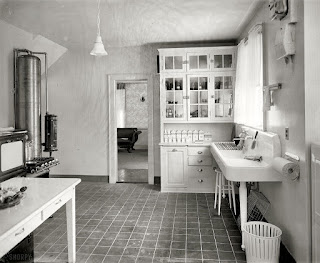 |
| Bungalow with a classic "six pack" floor plan, from a 1922 plan book by E. W. Stillwell and Co,—also the authors of the quote at the opening. |
This prescient advice, so apropos to the world we now live in, comes not from a modern-day tree hugger but rather from a California bungalow plan book of 1913. The humble little bungalow was a reply to the excesses of the Victorian era, and a very successful one: it went on to dominate the national housing market by the end of the 1920s. California bungalows are characterized by a simple, rectangular one-story floor plan, a prominent front porch, and a stucco exterior.
 |
| Classic California bungalow of a type that was built across the nation. Note the trademark tapered porch columns. |
 |
| Built-in sideboards and other cabinetry are bungalow hallmarks. |
So popular did the bungalow style become that virtually any town in the country is likely to have a picturesque row of them on some street or other. They're particularly plentiful in cities whose populations exploded during the boom years of the 20s—most notably, in Los Angeles.
The bungalow’s trademark is its massive front porch, which is carried on a pair of improbably stout “elephantine” columns. Ingenious builders came up with infinite variations on this porch design so that, despite the basic similarity of the bungalow plan, each home maintained its own personality. They added further variety by varying such small details as window muntins and rafter tails.
 |
| Bungalow bathrooms often featured bathrooms with extensive tile work in wild color schemes. (Image courtesy Brad Dixon, The New York Times) |
Bungalow interiors commonly feature built-in furniture such as sideboards in the dining room and built-in bookcases flanking the fireplace. A precious few examples retain their original bathrooms, featuring pedestal sinks and ceramic tile work in vibrant color combinations such as yellow and black or maroon and pink.
Bungalow drawbacks? A few. Privacy can be nil, since the basic "six pack" floor plan means that rooms often open directly onto one another rather than into a hallway. Bungalow kitchens are rudimentary at best, since they were designed to accommodate only a free-standing range, a small icebox and a sink and drainboard along with a few wall cupboards. These shortcomings have led most original kitchens to be remodeled several times over, with varying degrees of success.
 |
| Historical photo of a "model" bungalow kitchen, which was made intentionally small in reaction to the vast and complicated kitchens found in Victorian homes. |













